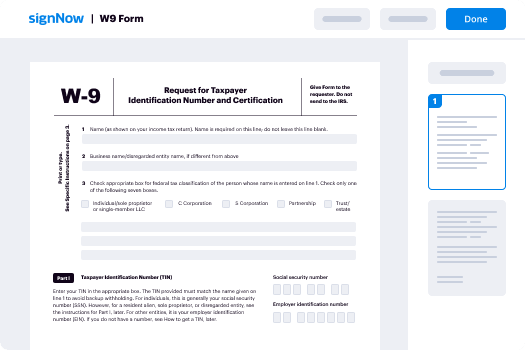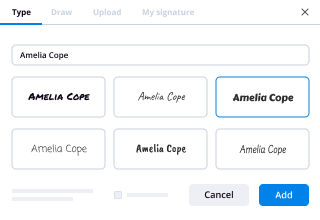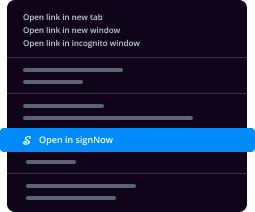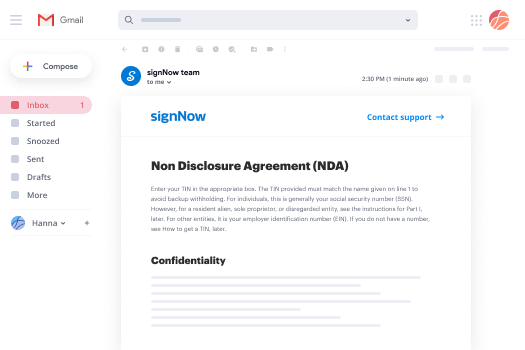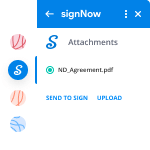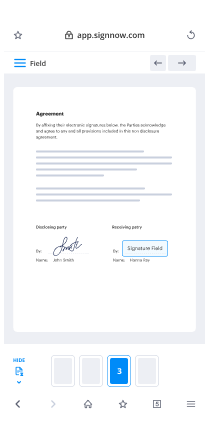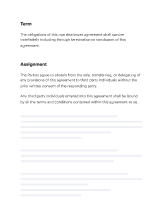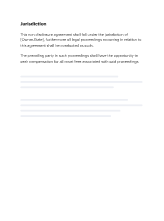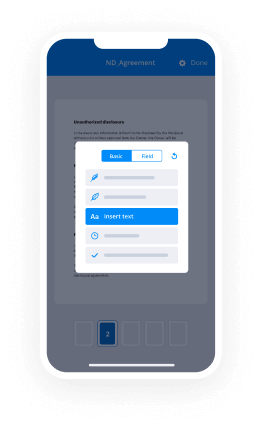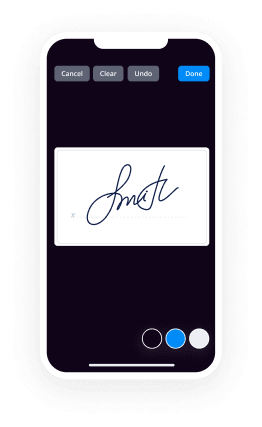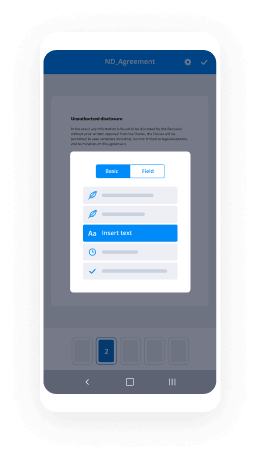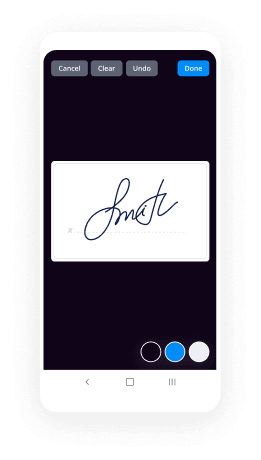Firma Electrónica vs. Firma Física
- Rápido para iniciar
- Fácil de usar
- Soporte 24/7
Las empresas con visión de futuro de todo el mundo confían en SignNow






Tu guía completa de cómo hacerlo
Hoy en día, probablemente no encontrarás una empresa que no utilice tecnologías modernas para automatizar el flujo de trabajo. La firma digital no es el futuro, sino el presente. Las empresas actuales que utilizan su facturación simplemente no quieren detener el software en línea que proporciona herramientas avanzadas de automatización de procesamiento de documentos, incluida la función de firma electrónica vs. firma física.
Cómo manejar la función de firma electrónica vs. firma física de airSlate SignNow:
-
Una vez que llegues a nuestro sitio web, inicia sesión o registra tu cuenta si no tienes una, te tomará solo unos momentos.
-
Subir el archivo de datos apropiado o seleccionar uno de tus carpetas de biblioteca: Documentos, Archivo, Plantillas.
-
Como resultado de la compatibilidad con el almacenamiento basado en la nube, puedes importar rápidamente el documento necesario desde las nubes preferidas con casi cualquier dispositivo.
-
Descubrirás tu documento de datos abierto en el Editor PDF actualizado donde puedes agregar ajustes antes de decidir continuar.
-
Escribe texto, inserta gráficos, incluye anotaciones o cuadros rellenables para completar más adelante.
-
Utiliza el botón Mi Firma para firmar tú mismo o coloca Campos de Firma para enviar la solicitud de eSign a uno o varios destinatarios.
-
Utiliza el botón HECHO cuando hayas terminado para continuar con la función de firma electrónica vs. firma física.
La plataforma del navegador airSlate SignNow es vital para aumentar la eficiencia y el rendimiento de la mayoría de los procesos de trabajo. La firma electrónica vs. firma física es una de las características que puede ayudar. Utilizar la aplicación basada en la web hoy en día es una necesidad, no una ventaja competitiva. ¡Pruébalo ahora!
Cómo funciona
Califica tu experiencia
What is the physical signature
A physical signature is a handwritten mark or sign made by an individual to signify agreement or acknowledgment on a document. This traditional method of signing involves physically writing one's name on paper, which serves as a legal validation of the signer's intent. While physical signatures have been widely used for centuries, the rise of digital technology has introduced alternative methods, such as electronic signatures, which offer greater convenience and efficiency in document management.
How to use the physical signature
To use a physical signature, an individual must first print the document that requires their signature. After reviewing the content, they can sign the document in the designated area, typically at the bottom or an assigned signature line. Once signed, the document can be scanned or photographed to create a digital copy, which can then be shared via email or other digital platforms. This method ensures that the physical signature is preserved while allowing for easy distribution and storage of the signed document.
Legal use of the physical signature
Physical signatures hold legal significance in the United States, often required for various agreements, contracts, and official documents. The Uniform Commercial Code (UCC) and the Electronic Signatures in Global and National Commerce (ESIGN) Act provide guidelines on the validity of signatures. While physical signatures are legally binding, it is essential to ensure that the signer has the capacity to sign and that the document is executed in compliance with relevant laws. Understanding the legal implications of a physical signature is crucial for maintaining the integrity of agreements.
Steps to complete the physical signature
Completing a physical signature involves several straightforward steps:
- Print the document that requires your signature.
- Read through the document carefully to understand its contents.
- Locate the signature line or designated area for signing.
- Sign your name in the appropriate space using a pen.
- Make sure the signature is clear and legible.
- Optionally, date the document if required.
- Scan or take a photo of the signed document to create a digital version.
Examples of using the physical signature
Physical signatures are commonly used in various scenarios, including:
- Signing contracts for rental agreements or leases.
- Completing tax forms and other government documents.
- Finalizing legal agreements, such as wills or power of attorney documents.
- Authorizing financial transactions, such as checks or loan applications.
- Signing employment contracts and HR-related documents.
Security & Compliance Guidelines
When using physical signatures, it is essential to adhere to security and compliance guidelines to protect sensitive information. Ensure that signed documents are stored securely to prevent unauthorized access. Additionally, consider using secure methods for sharing signed documents, such as encrypted email or secure file transfer services. Compliance with relevant regulations, such as the Health Insurance Portability and Accountability Act (HIPAA) for medical documents, is also crucial to maintain the confidentiality of personal information.
Digital vs. Paper-Based Signing
While physical signatures involve traditional pen-and-paper methods, digital signing offers a modern alternative that enhances efficiency. Digital signatures can be completed electronically, eliminating the need for printing and scanning. They provide benefits such as faster turnaround times, reduced paper usage, and easier storage and retrieval. Understanding the differences between digital and paper-based signing can help individuals and businesses choose the most suitable method for their needs.
¡Obtenga ahora firmas vinculantes desde el punto de vista jurídico!
-
Mejor ROI. Nuestros clientes logran un promedio de 7x ROI en los primeros seis meses.
-
Se adapta a sus casos de uso. De las PYMES al mercado medio, airSlate SignNow ofrece resultados para empresas de todos los tamaños.
-
Interfaz de usuario intuitiva y API. Firma y envía documentos desde tus aplicaciones en minutos.
Firma en línea FAQs
-
What is a physical signature and how does it differ from an electronic signature?
A physical signature is a handwritten mark made by an individual on a document, typically using a pen. Unlike electronic signatures, which are created digitally, physical signatures require the physical presence of the signer. Understanding the difference is crucial for businesses transitioning to digital solutions like airSlate SignNow. -
Can I use airSlate SignNow to create a physical signature?
While airSlate SignNow primarily focuses on electronic signatures, you can upload a scanned image of your physical signature to use in your documents. This allows you to maintain a personal touch while benefiting from the efficiency of digital signing. It's a great way to blend traditional and modern signing methods. -
What are the benefits of using airSlate SignNow over traditional physical signatures?
Using airSlate SignNow offers numerous benefits over traditional physical signatures, including faster turnaround times, reduced paper usage, and enhanced security. With electronic signatures, you can sign documents from anywhere, eliminating the need for physical presence. This streamlines your workflow and saves valuable time. -
Is airSlate SignNow compliant with legal standards for physical signatures?
Yes, airSlate SignNow complies with all legal standards for electronic signatures, making them as valid as physical signatures in many jurisdictions. This compliance ensures that your signed documents are legally binding and recognized by courts. You can confidently use airSlate SignNow for all your signing needs. -
What pricing plans does airSlate SignNow offer for businesses needing physical signature solutions?
airSlate SignNow offers flexible pricing plans tailored to meet the needs of businesses of all sizes. Each plan includes features that support both electronic and physical signatures, ensuring you have the tools necessary for efficient document management. Visit our pricing page for detailed information on each plan. -
Can airSlate SignNow integrate with other software for managing physical signatures?
Absolutely! airSlate SignNow integrates seamlessly with various software applications, enhancing your ability to manage both electronic and physical signatures. This integration allows you to streamline your processes and maintain a cohesive workflow across different platforms. Check our integrations page for a complete list of compatible applications. -
How secure is my information when using airSlate SignNow for physical signatures?
Security is a top priority at airSlate SignNow. We employ advanced encryption and security protocols to protect your information when using our platform for physical signatures. This ensures that your documents remain confidential and secure throughout the signing process.
Tu guía completa de cómo hacerlo
Solución confiable de eSignature
Únase a más de 28 millones de usuarios de airSlate SignNow
Obtener más
- Aumenta el cumplimiento con eSignatures: poder notarial ...
- Aumenta el cumplimiento con eSignatures: poder notarial ...
- Aumenta el cumplimiento con eSignatures: poder notarial ...
- Comienza con eSignature: programa para completar ...
- Transforma un PDF en un Documento Interactivo: maneras ...
- Comienza tu viaje de eSignature: firma un pdf en pc
- Aumenta el cumplimiento con eSignatures: firma acuerdo ...
- Comienza tu viaje de eSignature: firmar documento pdf ...




















